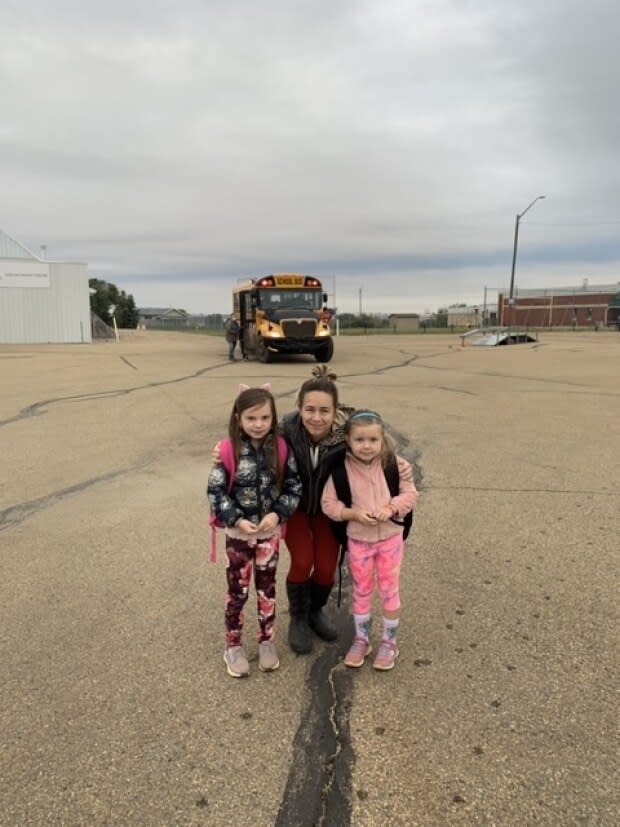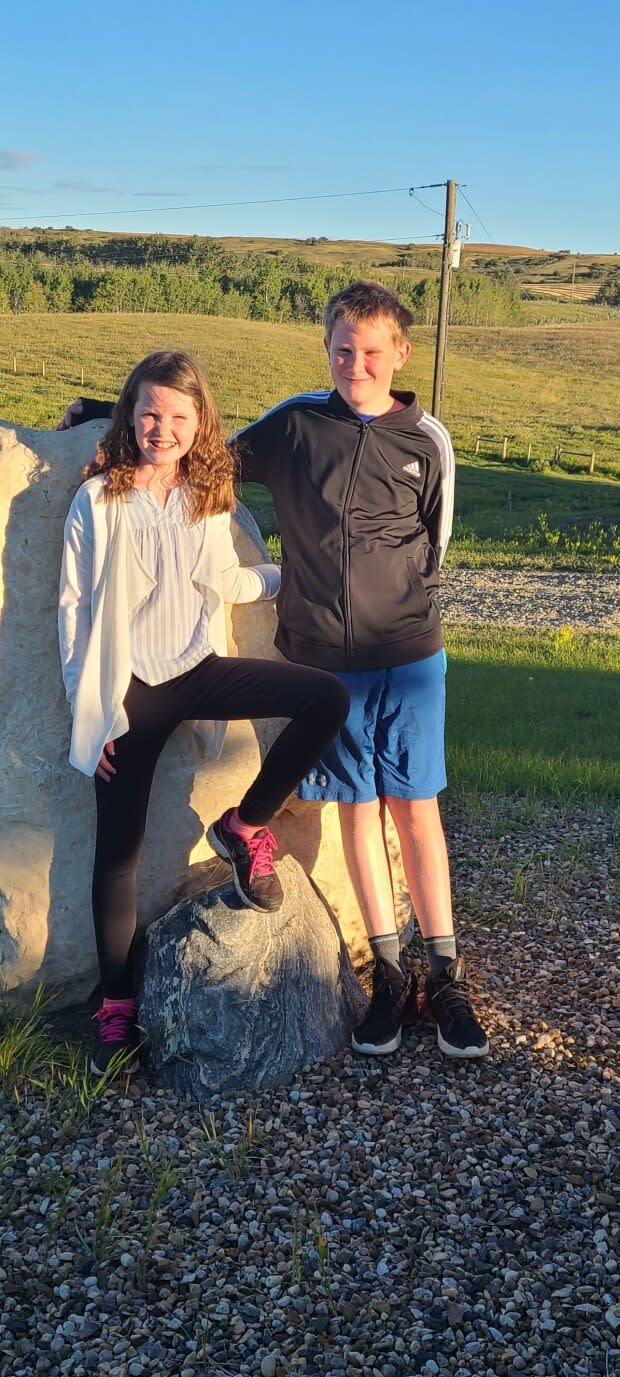Hardisty, the 'nerve centre' of Alberta's oil industry, loses its only school
If Canadian crude oil is destined for the United States, it likely went through a pipe in Hardisty, Alberta.
The town, 200 kilometres southeast of Edmonton, will be the starting point of the Keystone XL pipeline, in which Alberta own a $1.5-billion stake. It's a key point on Enbridge's Line 3 and Express pipelines, home to a sprawling tank farm that stores millions of barrels of crude oil and the site of a future pipeline control centre for a North American network.
Hundreds of people are employed by the oil industry in Hardisty — and now, it has no school.
Blake Moser's first child, Patrick, was two days old when the Battle River public school board voted in March to shutter Allan Johnstone K-9 school. The board ruled it was no longer viable.
Chair of the Hardisty and District Development Group, Moser had been one of several community members advocating to keep the school open in a town he calls the "nerve centre" of Canadian oil.
"Our group believes that a school and a hospital are probably the most important parts, the main pillars of any community, and in order to grow a community, in order to support growth within that community, we really need that school to be there," he said in an interview.
He says there's a potential solution — a simple solution — that could open up more school choices for Hardisty students, and even a glimmer of hope that Johnstone school could re-open.
He wants the provincial government to step in and move the school division boundary. But no one in power seems keen to do it.
"I don't think it's right that the school division can dictate the fate of a town or an area, which in turn, can dictate the fate of an economy," he said.
The trouble with border towns
Hardisty is on the eastern edge of the Camrose-based Battle River school division.
Four kilometres away is the boundary line for the Wainwright-based Buffalo Trail school division.
High school students in Hardisty ride the bus for free to Central High Sedgewick Public School, 32 kilometres to the west. Now, the Battle River division also transports about 30 more K-9 students from Hardisty to school in Sedgewick.
However, when Johnstone school closed, some Hardisty families didn't want to send their children to Sedgewick.
Some parents told CBC their connections are stronger with people in the nearby communities of Irma, Amisk and Hughenden. Their children play sports and take dance class together. Some Hardisty workers live in the communities. Irma also has a glimmering new K-12 school that opened in November 2019.
But Irma, Amisk and Hughenden and their schools are in the Buffalo Trail school division. And when families asked Battle River to bus their children to Irma, division leaders said no.
In an interview, board chair Karen Belich said transporting kids outside boundaries is not something school divisions do.

Then, parents asked both divisions if they could tweak busing boundaries so Buffalo Trail buses could pick up Hardisty kids. The divisions also said no.
And so members of the community chartered their own school bus. They contracted a vehicle, hired a driver, and began to raise the $48,000 a year necessary to bus kids across the border to Irma.
Why the ride is worth the cost
Looking at Battle River's empty financial reserves and $2-million operating deficit, parent Brittany MacMillan said sending her two older children to school in Irma was a better choice.
"I didn't want to put my kids into that mess," she said.

She organized a silent auction online that raised about $20,000 in a week. Volunteers held a bottle drive that raised $5,000. People began walking up to MacMillan on the street and handing her money for the bus. So far, they've raised $36,000, which has nudged the remaining cost per child down to $40 a month.
"Our community is fired up, and we mean business," she said in an interview. "We're finding a solution one way or another."
Thirty-three kids now meet the school bus in Hardisty daily to ride to Irma. Development group chair Moser said it would be more, but some working parents rely on school buses that can collect children outside their doors.
Some families chose Irma over Sedgewick because they felt betrayed by Battle River's move to close their school. Kristie Foster has three children, ages 12, 10 and five, who ride the hired bus to school in Irma from Hardisty.
She said Battle River trustees seemed more concerned with losing the provincial funding attached to the students than finding a solution that worked for families.
"We want our kids to be in a school division that we trust," Foster said. "And when you break that trust, you know, it's hard to have your children involved in a division that you don't trust."
Battle River leaders say they tried for at least seven years to keep Johnstone school afloat as enrolment plummeted. With room for nearly 200 students, enrolment steadily slid from 179 pupils in 1995 to just 48 last year.
Division spokesperson Diane Hutchinson said they poured extra money into staffing the school to keep it open.
But the economic activity in Hardisty was not translating into children living in the town.
Moser surveyed employers about their job-creation plans and estimates the number of kids moving into Hardisty could jump substantially in the next five years.
Battle River's projections are nowhere near as optimistic.
Minister reluctant to intervene
MacMillan loves her kids' school in Irma. She says the community and staff have been friendly and welcoming.
However, she says parents can't keep pleading with local oil companies and citizens for donations to keep the private bus running — it's unsustainable.
Hardisty Mayor Doug Irving said the school closure is a major loss for a town that is otherwise humming.
"Without a school, you don't really have a viable town life," he said.
Although shorter-term workers fill Hardisty hotel rooms and patronize businesses, Irving is worried about the school closure's effect on the town's tax base.
He's already seen some families leave Hardisty. It's easier for families to have kids live next to a school and have a parent drive 30 kilometres on the highway to work, he said.
He's disillusioned with the lack of consultation between the school board and town council. When he talks to folks in the provincial government, they tell him, sorry, school boards control which schools stay open.
An education minister could, however, alter a school division boundary. She also has the power, under the Education Act, to require school boards to co-operate on student transportation.
In an email, Colin Aitchison, press secretary to Education Minister Adriana LaGrange, said the minister respects Battle River's authority to decide the fate of school in Hardisty.
Enrolment seems unlikely to improve with much of Hardisty's workforce either commuting into the area or being single people without children, he said.
He said it's up to school boards to decide if they want to co-operate on transportation.
Does the Buffalo Trail school board want Hardisty in its boundaries? Board chair Lanie Parr said the two school boards met earlier this year, and Battle River was not interested in having Buffalo Trail operate the Hardisty school. Both divisions agreed neither was in a position to run Johnstone school this year. After that, Buffalo Trail stepped away, Parr said.
In an email, Husky Energy said that schools are an important factor in attracting and keeping skilled permanent employees where they operate. The company has 13 permanent employees and as many as 200 contractors on site during busy times.
"We are concerned that our employees, contractors and service providers may be forced to leave the community due to the impact this decision could have on their families," spokesperson Dawn Delaney said.
Enbridge, which has about 45 permanent employees and 50 temporary contractors working in the Hardisty area, said most workers commute from surrounding communities such as Sedgewick, Lougheed and Wainwright.
Moser, who grew up in Hardisty and moved back after university, says he'll keep pushing for a solution and help from politicians.
"If Hardisty can't make it, then rural Alberta can't make it."


